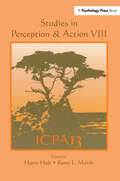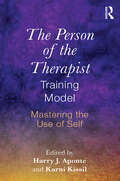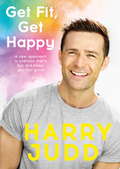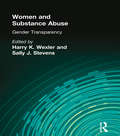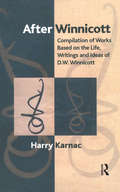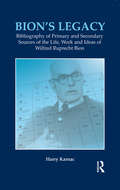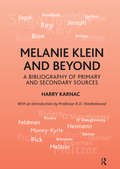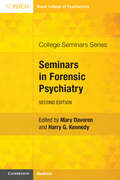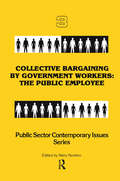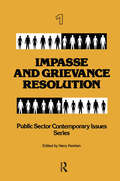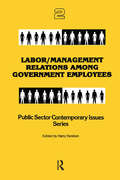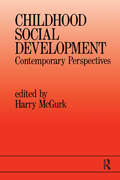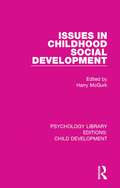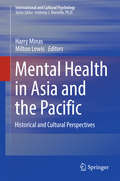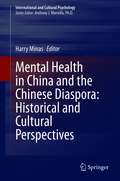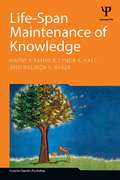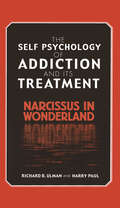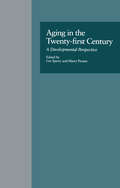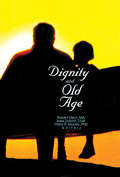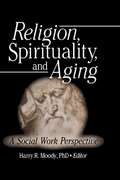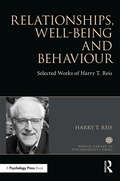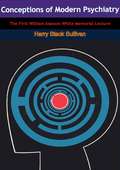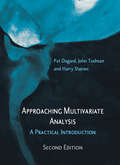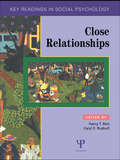- Table View
- List View
Studies in Perception and Action VIII: Thirteenth international Conference on Perception and Action (Studies In Perception And Action Ser.)
by Harry Heft Kerry L. MarshSince 1991, the edited book series Studies in Perception and Action has appeared in conjunction with the biennial International Conference of Perception and Action (ICPA), a conference that provides an opportunity for individuals who share interests in ecological psychology to come together to present current research, exchange ideas, and engage in conversation on theoretical and methodological concerns. The Studies in Perception and Action series is a way to preserve the dialogues between conference attendees and researchers displaying their latest work. This volume, the eighth in the series, presents the conversations held at the 13th ICPA meeting in the summer of 2005. Studies in Perception and Action VIII includes broad coverage of the most current advances in research on perceiving and acting, including contributions from researchers in Australia, China, Japan, Europe, and North America. It addresses cutting-edge research in dynamics and human movement, recent progress in ecological approaches to perceiving and acting, and substantially extends our knowledge of just how rich a source of information the world is across a wide range of modalities. This volume will appeal to individuals who follow the research literature in ecological psychology, as well as those interested in perception, perceptual development, human movement dynamics, and social processes.
The Person of the Therapist Training Model: Mastering the Use of Self
by Harry J. Aponte and Karni KissilThe Person of the Therapist Training Model presents a model that prepares therapists to make active and purposeful use of who they are, personally and professionally, in all aspects of the therapeutic process—relationship, assessment and intervention. The authors take a process that seems vague and elusive, the self-of-the-therapist work, and provide a step-by-step description of how to conceptualize, structure, and implement a training program designed to facilitate the creation of effective therapists, who are skilled at using their whole selves in their encounters with clients. This book looks to make conscious and planned use of a therapist’s race, gender, culture, values, life experience, and in particular, personal vulnerabilities and struggles in how he or she relates and works with clients. This evidence-supported resource is ideal for clinicians, supervisors, and training programs.
Get Fit, Get Happy: A new approach to exercise that's fun and helps you feel great
by Harry JuddGet Fit, Get Happy isn't about just transforming the way you look.It's about transforming the way you feel. Harry Judd is a member of the hugely successful bands McFly and McBusted who have headlined Hyde Park, notched up 19 hit singles - of which 7 went to number one - and 2 number-one albums. He is a much-loved former Strictly Come Dancing champion and has been crowned the nation's favourite ever winner of the show.And yet in spite of this success, there have been times when Harry has been prone to anxiety and other mental health issues. He's not alone. Today, anxiety, depression and other mental health problems affect more of us than ever before and we are all looking for ways to adapt, cope and survive the pressures of daily life.The one thing that Harry has turned to time and time again to redress the balance in his life is fitness. Now, using a combination of exercise and dance, Harry makes the mood-boosting benefits of fitness accessible for everyone. Young or old, male or female, small or large, tall, short, thin, fat or somewhere in the middle: anyone will be inspired by Get Fit, Get Happy. Without any need for expensive kit or lots of time, Harry's approach is fun, fast, free. Part memoir in which Harry tells the life lessons that he has learned, and part richly researched fitness plan to get you feeling more positive, Get Fit, Get Happy is a fitness revolution to help people find a little more happiness in their lives.
Get Fit, Get Happy: A new approach to exercise that's fun and helps you feel great
by Harry JuddGet Fit, Get Happy isn't about just transforming the way you look.It's about transforming the way you feel. Harry Judd is a member of the hugely successful bands McFly and McBusted who have headlined Hyde Park, notched up 19 hit singles - of which 7 went to number one - and 2 number-one albums. He is a much-loved former Strictly Come Dancing champion and has been crowned the nation's favourite ever winner of the show.And yet in spite of this success, there have been times when Harry has been prone to anxiety and other mental health issues. He's not alone. Today, anxiety, depression and eating disorders affect more of us than ever before and we are all looking for ways to adapt, cope and survive the pressures of daily life.The one thing that Harry has turned to time and time again to redress the balance in his life is fitness. Now, using a combination of exercise and dance, Harry makes the mood-boosting benefits of fitness accessible for everyone. Young or old, male or female, small or large, tall, short, thin, fat or somewhere in the middle: anyone will be inspired by Get Fit, Get Happy. Without any need for expensive kit or lots of time, Harry's approach is fun, fast, free. Part memoir in which Harry tells the life lessons that he has learned, and part richly researched fitness plan to get you feeling more positive, Get Fit, Get Happy is a fitness revolution to help people find a little more happiness in their lives.The fully illustrated Get Fit, Get Happy Fitness Plan can be found in the accompanying PDF to this audiobook. (P)2017 Hodder & Stoughton
Women and Substance Abuse: Gender Transparency
by Sally J Stevens Harry K WexlerIn Women and Substance Abuse: Gender Transparency you’ll see what can be done to aid women in some of the world’s hardest hit substance abuse hubs, including Rio De Janeiro, Brazil; Philadelphia, Pennsylvania; and New Haven, Connecticut. Filled with timely research and practical solutions, this volume shows you what you can do to aid the tremendous and immediate need for specialized interventions in the lives of women.Women and Substance Abuse considers many of the variables in the lives of women who abuse drugs--race, choice of drug, HIV risk, and drug treatment history--and gives you line-by-line proof of the need for custom-tailored harm reduction strategies for addicted women who are and who aren’t engaged in drug treatment therapy. In addition, you’ll see why frequent cocaine use, current physical and sexual abuse, and concerns relating to children can alter the success of therapies and treatments. Overall, this unique volume will broaden your understanding of the subject by covering: gender differences in risk for gonorrhea infection risk factors for women who trade sex for drugs and money the role of physicians and prenatal care providers of substance abusing women how drug treatment programs can be more multifacted to include planning, prenatal care, and parenting skills prison-based therapeutic communities long-term residential treatment for women with children, pregnant women, and women without childrenFor every unique woman with a drug problem, there is a unique treatment. Women and Substance Abuse turns away from the lost cause of blanket treatments and takes you into the world’s slums and inner-city ghettoes, where the faces of addiction are as diverse as the women who bear its debilitating burdens. You’ll see women’s drug addiction for what it is--a montage of suffering and pain that only individual and specialized care can cure.
After Winnicott: Compilation of Works Based on the Life, Writings and Ideas of D.W. Winnicott
by Harry KarnacThis bibliography is based on the plethora of ideas introduced into the psychoanalytic lexicon by Donald Woods Winnicott. It demonstrates amply how wide the range is of Winnicott scholarship and facilitates post-Freudian Bion and Winnicott studies.
Bion's Legacy: Bibliography of Primary and Secondary Sources of the Life, Work and Ideas of Wilfred Ruprecht Bion
by Harry KarnacThis book forms a comprehensive bibliography of the works of W. R. Bion, and the other works that made some bearing of his life and thought. It discusses Bion's contribution to various disciplines beyond the psychoanalytic and psychotherapeutic.
Melanie Klein and Beyond: A Bibliography of Primary and Secondary Sources
by Harry KarnacThis book is a bibliography of Melanie Klein's writings together with other books, articles, and papers, dealing with her life, ideas and work. It is of immense potential use for clinicians, students, and researchers.
Seminars in Forensic Psychiatry (College Seminars Series)
by Harry Kennedy Mary DavorenThis updated edition of Seminars in Forensic Psychiatry is an invaluable guide for consultants and specialist trainees working in forensic psychiatry. Written by leading international contributors, topics include models of care, the management of in-patient violence, forensic psychotherapy, and psychological treatments. The evolution of policy and mental health law is discussed, demonstrating how it has shaped the provision of forensic psychiatry services. Legal aspects include considerations of mentalistic defences in criminal law, mental health law, as well as the law on negligence. The book also includes sections on specialist areas of need, including cultural and gender specific needs, terrorism, stalkers, and sex offenders. Woven into the chapters are practical approaches, and 'how to' guides. The volume ends with advice for each of the transitions in the career of a forensic psychiatrist. A truly practical guide, this is a must-read for psychiatrists and mental health professionals working within a forensic setting.
Collective Bargaining by Government Workers: The Public Employee (Public Sector Contemporary Issues #Vol. 3)
by Harry KershenThe chapters in this anthology deal with many of these all-encompassing constraints and how the various participants seek to deal with them. Model agreements, negotiating levers, the balance of power between managers and government employees, contracting-out versus producing in-house, the impact of bargaining unit structure on productivity, the relationship of municipal budget making to collective bargaining, public employee union growth and organizing trends, and many other topics are dealt with in this volume. These issues are discussed in the context of several specific types of public employees such as: municipal protection employees, mass transit workers, health professionals in relation to government service, and, the armed forces and civilian federal employees.
Impasse and Grievance Resolution (Public Sector Contemporary Issues)
by Harry KershenPraised by reviewers as a superior book in the field of public sector bargaining, "Impasse and Grievance Resolution" is the classic "how to" text for the resolution of new contract disputes and ongoing contract grievances. Comprehensive, up-to-date, full of good practical advice. "Impasse and Grievance Resolution" is the ideal addition to your own professional library.
Labor/management Relations Among Government Employees (Public Sector Contemporary Issues)
by Harry KershenIncludes articles which offer a mix of theoretical analysis, case history and empirical research, interspersed with good, practical advice from those who have sat long hours at the bargaining table.
Childhood Social Development: Contemporary Perspectives
by Harry McGurkThis book provides an account of research in action and debate in progress in a selection of areas of childhood social development where significant progress is underway. The chapters are written by an eminent group of British and American developmental psychologists each of whom has made primary contributions to research in the areas covered in the volume. The contributors were invited to reflect upon the current scene in social developmental research and to develop their own distinctive viewpoint and contribution to the field. The book addresses issues in social development from infancy to adolescence. The topics examined include: interactions between biological and social factors in social development; sex role development; the development of friendships; the role of peer interaction in social and cognitive development; and the influence of cultural artifacts in the social and cognitive development of children. Although each chapter is concerned with a different aspect of social development, there are a number of themes that recur throughout the volume. One concerns the nature of social development: the acquisition of social understanding and the development of social skills are not individual achievements of children reared in isolation. Rather, they are the outcome of social processes in which the developing child engages, sometimes in an unequal partnership with experienced adults; at other times in more equal partnership with peers and playmates. In both cases the development change is a constructive outcome. A second recurrent theme is a concern for developmental researchers to take fuller account than they may traditionally have done of the nature of the cultural settings in which social development occurs. Different cultures have different customs and artifacts, and these can constrain development in different ways. This issue is considered throughout the book and is the specific focus of the final chapter.
Issues in Childhood Social Development (Psychology Library Editions: Child Development #5)
by Harry McgurkOriginally published in 1978, contemporary theory and research into childhood social development had demonstrated the necessity to re-appraise the notion that socialization is merely a process of shaping the behaviour of the child to fit the mores of society. It was now evident that, from the beginnings of post-partum life, the human infant is an active participant in social encounters, modifying the behaviour of others as well as being influenced by them. Hence, social development must be construed as an interactive process, to which the young organism makes his own dynamic contribution. This book, comprising a collection of original essays by prominent investigators in the field, considers issues arising from this modified perspective. It examines the biological basis of social development, the role of child-caretaker interaction, the significance of sex differences, the influence of peer relations and the perceptual-cognitive factors which contribute to childhood social development and to the developing child’s understanding of society.
Mental Health in Asia and the Pacific
by Harry Minas Milton LewisThis far-reaching volume analyzes the social, cultural, political, and economic factors contributing to mental health issues and shaping treatment options in the Asian and Pacific world. Multiple lenses examine complex experiences and needs in this vast region, identifying not only cultural issues at the individual and collective levels, but also the impacts of colonial history, effects of war and disasters, and the current climate of globalization on mental illness and its care. These concerns are located in the larger context of physical health and its determinants, worldwide goals such as reducing global poverty, and the evolving mental health response to meet rising challenges affecting the diverse populations of the region. Chapters focus on countries in East, Southeast, and South Asia plus Oceania and Australia, describing: #65533; National history of psychiatry and its acceptance. #65533; Present-day mental health practice and services. #65533; Mental/physical health impact of recent social change. #65533; Disparities in accessibility, service delivery, and quality of care. #65533; Collaborations with indigenous and community approaches to healing. #65533; Current mental health resources, the state of policy, and areas for intervention. A welcome addition to the global health literature, Mental Health in Asia and the Pacific brings historical depth and present-day insight to practitioners providing services in this diverse area of the world as well as researchers and policymakers studying the region.
Mental Health in China and the Chinese Diaspora: Historical and Cultural Perspectives (International and Cultural Psychology)
by Harry MinasFollowing on the previous volume, Mental Health in Asia and the Pacific, which was co-edited with Milton Lewis, this book explores historical and contemporary developments in mental health in China and Chinese immigrant populations. It presents the development of mental health policies and services from the 19th Century until the present time, offering a clear view of the antecedents of today’s policies and practice. Chapters focus on traditional Chinese conceptions of mental illness, the development of the Chinese mental health system through the massive political, social, cultural and economic transformations in China from the late 19th Century to the present, and the mental health of Chinese immigrants in several countries with large Chinese populations. China’s international political and economic influence and its capabilities in mental health science and innovation have grown rapidly in recent decades. So has China’s engagement in international institutions, and in global economic and health development activities. Chinese immigrant communities are to be found in almost all countries all around the world. Readers of this book will gain an understanding of how historical, cultural, economic, social, and political contexts have influenced the development of mental health law, policies and services in China and how these contexts in migrant receiving countries shape the mental health of Chinese immigrants.
Life-Span Maintenance of Knowledge (Essays in Cognitive Psychology)
by Harry P. Bahrick Lynda K. Hall Melinda K. BakerThis volume describes how well we maintain the knowledge we acquire throughout life. Research traditionally focuses on memory for events that are retained over short time periods that can be accommodated in experiments. This book, by contrast, uniquely describes the evolution of methods suitable for investigating memory of complex knowledge acquired over several years and retained during the entire life-span. The methods substitute statistical for experimental controls, and the investigations involve several hundred participants whose memory is tested up to 50 years after they acquired the knowledge in question. The book covers educational content, such as mathematics and foreign languages; knowledge acquired incidentally, such as the streets and buildings of the cities in which we live; and knowledge acquired through the media. Previously unpublished research on age-related access to knowledge is included. The analyses are based on the accessibility/availability ratio, a metric presented for the first time. This metric allows comparisons of the portion of available knowledge that can be recalled as a function of age, education and other individual differences, and as a function of the domain of knowledge in question. The ratio can be used to evaluate methods of instruction and methods of studying. It can also be used to evaluate memory development and to diagnose memory pathology. The volume will be of interest to researchers in human memory, developmental psychologists, gerontologists in academic and applied settings, and educators.
The Self Psychology of Addiction and its Treatment: Narcissus in Wonderland
by Harry Paul Richard B. UlmanIn the time of Freud, the typical psychoanalytic patient was afflicted with neurotic disorders; however, the modern-day psychotherapy patient often suffers instead from a variety of addictive disorders. As the treatment of neurotic disorders based on unconscious conflicts cannot be applied to treatment of addictive disorders, psychoanalysis has been unable to keep pace with the changes in the type of patient seeking help. To address the shift and respond to contemporary patients’ needs, Ulman and Paul present a thorough discussion of addiction that studies and analyzes treatment options. Their honest and unique work provides new ideas that will help gain access to the fantasy worlds of addicted patients. The Self Psychology of Addiction and Its Treatment emphasizes clinical approaches in the treatment of challenging narcissistic patients struggling with the five major forms of addiction. Ulman and Paul focus on six specific case studies that are illustrative of the five forms of addiction. They use the representative subjects to develop a self psychological model that helps to answer the pertinent questions regarding the origins and pathway of addiction. This comprehensive book links addiction and trauma in an original manner that creates a greater understanding of addiction and its foundations than any clinical or theoretical model to date.
Aging in the Twenty-first Century: A Developmental Perspective (Issues in Aging)
by Len Sperry Harry ProsenCovering a wide range of topics, this collection of original essays deals with the consequences and challenges of our growing aging population on society. It emphasizes aging as a developmental process while addressing the future of the practice of geropsychiatry and geriatric psychotherapy. This book serves as a valuable resource to guide clinical training, practice, and research on aging into the next century and beyond.
Dignity and Old Age
by Harry R Moody Rose Dobrof Robert DischOpen up Dignity and Old Age, and you’ll find a wealth of thoughtful suggestions for how you and others can gain more respect and admiration for your relatives, neighbors, and patients who are in the latter stages of life. You’ll examine the word “dignity” as it relates to the world’s elderly population to the fullest and most challenging extent, taking into account cross-cultural, religious, and even literary influences. Throughout this provoking and thorough examination, you’ll tackle some tough questions, all of which will equip you with the theoretical and practical know-how needed to evoke change and preserve honorable relations with the elderly persons in your professional and personal relationships.The manner in which Dignity and Old Age will help you grow in your relationships with elderly people is twofold--ideally and practically. You’ll begin with a revitalizing discussion of concepts that revolve around dignity and the elderly, and from there you’ll move into the sphere of active practice, gleaning a wide variety of ways you can enhance your affairs with the elderly in health care, social services, government, and retirement entitlements and benefits. Specifically, you’ll find positive approaches in these and other areas: the dignity in old age the true meaning of “Quality of Life” in old age achieving respect for ethnic elders as a health care provider bringing spirituality and community together in the last stage of life forming a philanthropic, caring partnership between government and the elderlyIn this insightful volume, you’ll take an important step forward in creating a more dignified quality of life for the world’s elderly--today’s and tomorrow’s. Overall, you’ll gain the variety of perspectives necessary to ensure that everyone you come in contact with in casual, legal, leisure, and professional spheres will see you care enough to be concerned with the ideas and practices contained in Dignity and Old Age.
Religion, Spirituality, and Aging: A Social Work Perspective
by Harry R MoodyLearn how to make a more positive impact with your social work with the agedReligion is an important coping mechanism for many aging adults. Religion, Spirituality, and Aging: A Social Work Perspective presents the latest research that shows how religion and spirituality can improve quality of life for elders. Respected social work researchers and scholars provide insight and practical methods for fostering positive aging while also considering how spirituality and religion can affect practitioners themselves. The full range of advantages and ethical implications are discussed in clear detail from a social work viewpoint. Case studies plainly illustrate the positive impact that the inclusion of spirituality and religion in an aging person&’s life may have on their physical and mental welfare.Organized social work in the early twentieth century actively tried to distance itself from its roots as a form of religious charity in favor of becoming a scientific and professional endeavor. Religion, Spirituality, and Aging once again bridges the gap between social work and spiritual matters by presenting penetrating articles that discusses the issues of the aging soul while examining ways to improve care. Creative strategies are offered to contribute to the spiritual side of aging while considering every implication and ethical question. The compilation is extensively referenced and includes helpful figures and tables to clearly illustrate data and ideas.Religion, Spirituality, and Aging discusses: the latest social work trends and attitudes toward spirituality prayer, meditation, and acts of altruism as interventions an empirical study of how social workers use religion and spirituality as an intervention ethical considerations and best practices religion and spirituality during long-term care the "Postcards to God" project dreams and their relationship to the search for meaning in later life a spiritual approach to positive aging through autobiography dementia and spirituality creating new rituals for sacred aging spiritual master Henri Nouwen&’s principles of aging-and his approaches to caring for older people an interview study on elders&’ spirituality and the changes manifested in their views of religionReligion, Spirituality, and Aging is a remarkable reminder that elders are our future selves. This erudite, well-reasoned examination of aging and spirituality from a social work perspective is crucial reading for social workers, human service professionals who work with the aged, and gerontology scholars.
Relationships, Well-Being and Behaviour: Selected works of Harry Reis (World Library of Psychologists)
by Harry ReisIn the World Library of Psychologists series, international experts themselves present career-long collections of what they judge to be their finest pieces - extracts from books, key articles, salient research findings, and their major practical theoretical contributions. In this fascinating volume, Harry Reis reflects on a career that has earned him an international reputation as an eminent scholar and pioneer in the field of relationship science, through a selection of papers that illustrate the foundational theme of his research career: the importance of relationships for human well-being. The book charts the development of research in social psychology and relationship science through three key themes; from the relationship context of human behaviour, through to the value of studying behaviour in its natural context, and finally intimacy and responsiveness in close relationships. Also featuring a newly written introduction by the author contextualizing the selections and offering an intimate overview of his career, this collection of key publications offers a unique and compelling insight into decades of groundbreaking work, making it an essential resource for all those engaged or interested in the psychology of relationships and well-being.
Conceptions of Modern Psychiatry: The First William Alanson White Memorial Lecture
by Harry Stack SullivanThe central ideas making up Harry Stack Sullivan’s theory of personality find their first expression in this book. Here he set forth his view of psychiatry as the study of interpersonal relations. “Psychiatry,” he wrote, “is the study of processes that involve or go on between people. The field of psychiatry is the field of interpersonal relations under any and all circumstances in which these relations exist. A personality can never be isolated from the complex of interpersonal relations in which the person lives and has his being.”Through his development of the theory of interpersonal relations, Harry Stack Sullivan not only made a vital contribution on the treatment of mental disorder—in particular, schizophrenia—but he opened an entirely new approach to the study of human personality. “The core of Sullivan’s theory,” says Lloyd Frankenberg in the New York Times, “is that people, interacting, shape people….He has evolved an analytic method, for all its subtlety and elaboration, wonderfully coherent, organic and usable.”The influence of Harry Stack Sullivan has had a powerful impact. He has been called one of the half dozen truly great figures in American social psychology, one who has opened new horizons of research and, in the view of many analysist, made the most original contribution to psychiatry since Freud.
Approaching Multivariate Analysis, 2nd Edition: A Practical Introduction
by John Todman Pat Dugard Harry StainesThis fully updated new edition not only provides an introduction to a range of advanced statistical techniques that are used in psychology, but has been expanded to include new chapters describing methods and examples of particular interest to medical researchers. It takes a very practical approach, aimed at enabling readers to begin using the methods to tackle their own problems. This book provides a non-mathematical introduction to multivariate methods, with an emphasis on helping the reader gain an intuitive understanding of what each method is for, what it does and how it does it. The first chapter briefly reviews the main concepts of univariate and bivariate methods and provides an overview of the multivariate methods that will be discussed, bringing out the relationships among them, and summarising how to recognise what types of problem each of them may be appropriate for tackling. In the remaining chapters, introductions to the methods and important conceptual points are followed by the presentation of typical applications from psychology and medicine, using examples with fabricated data. Instructions on how to do the analyses and how to make sense of the results are fully illustrated with dialogue boxes and output tables from SPSS, as well as details of how to interpret and report the output, and extracts of SPSS syntax and code from relevant SAS procedures. This book gets students started, and prepares them to approach more comprehensive treatments with confidence. This makes it an ideal text for psychology students, medical students and students or academics in any discipline that uses multivariate methods.
Close Relationships: Key Readings (Key Readings in Social Psychology)
by Harry T. ReisEach of the chapters in this reader is written by leading scholars in the area of relationships, reflecting the diversity of the field and including both contemporary and key historical papers for comprehensive coverage of research.
